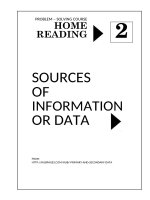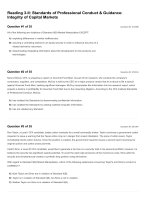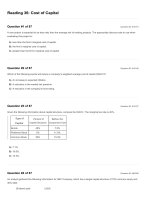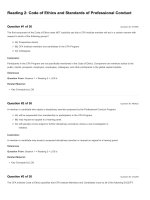Reading 29 sources of capital answers
Bạn đang xem bản rút gọn của tài liệu. Xem và tải ngay bản đầy đủ của tài liệu tại đây (224.13 KB, 12 trang )
Question #1 of 24
Question ID: 1378684
An analyst has calculated the following statistics for Company X and Company Y.
Company X
Company Y
Year 1 Year 2 Year 1 Year 2
Number of days of inventory
18
22
33
24
Number of days of receivables
14
16
14
12
Number of days of payables
19
20
18
20
The net operating cycle for:
A)
Company X was 18 days in year 2, an improvement in liquidity compared to year
1.
B) Company Y was 36 days in year 2, a decline in liquidity compared to year 1.
C)
Company Y was 16 days in year 2, an improvement in liquidity compared to year
1.
Explanation
Net operating cycle is calculated as the number of days of inventory + number of days of
receivables − number of days of payables. Company Y's net operating cycles were 33 + 14
− 18 = 29 days in year 1 and 24 + 12 − 20 = 16 days in year 2. The decline in net operating
cycle days in year 2 indicates an improvement in liquidity. For Company X, the net
operating cycle for year 2 was 22 + 16 − 20 = 18 days, an increase from year 1, which was
18 + 14 − 19 = 13 days.
Question #2 of 24
Question ID: 1383116
An analyst computes the following ratios for Iridescent Carpeting Inc. and compares the
results to the industry averages:
Financial Ratio
Iridescent Carpeting Industry Average
Current Ratio
2.3
1.8
Net Profit Margin
22%
24%
Return on Equity
17%
20%
Total Debt / Total Capital
35%
56%
Interest Coverage Ratio
4.7
4.1
Based on the above data, which of the following can the analyst conclude? Compared to its
competitors, Iridescent Carpeting is more:
A) profitable.
B) leveraged.
C) liquid.
Explanation
Based on the data provided, the analyst can conclude that the company has better shortterm liquidity than the industry average (i.e., its competitors) based on the current ratio.
The analyst can conclude that Iridescent Carpeting has weaker profitability than its
competitors based on the net profit margin and return on equity. The analyst can also
conclude that the company has less financial leverage (risk) than the industry average
based on the total debt / total capital ratio.
(Study Session 9, Module 29.1, LOS 29.c)
Question #3 of 24
Question ID: 1378675
A firm has average days of receivables outstanding of 22 compared to an industry average
of 29 days. An analyst would most likely conclude that the firm:
A) has better credit controls than its peer companies.
B) may have credit policies that are too strict.
C) has a lower cash conversion cycle than its peer companies.
Explanation
The firm's average days of receivables should be close to the industry average. A
significantly lower average days receivables outstanding, compared to its peers, is an
indication that the firm's credit policy may be too strict and that sales are being lost to
peers because of this. We can not assume that stricter credit controls than the average for
the industry are "better." We cannot conclude that credit sales are less, they may be more,
but just made on stricter terms. The average days of receivables are only one component
of the cash conversion cycle.
(Study Session 9, Module 29.1, LOS 29.c)
Question #4 of 24
Question ID: 1378678
Which of the following most accurately represents the cash conversion cycle?
A)
B)
C)
average days of receivables + average days of inventory + average days of
payables.
average days of payables + average days of inventory – average days of
receivables.
average days of receivables + average days of inventory – average days of
payables.
Explanation
The cash conversion cycle, also called the net operating cycle is:
cash
average days
average days
conversion = (
) + (
of receivables
average days
) – (
of inventory
)
of payables
cycle
The cash conversion cycle measures the length of time required to convert a firm's cash
investment in inventory back into cash resulting from the sale of the inventory. A short
cash conversion cycle is good because it indicates a relatively low investment in working
capital.
(Study Session 9, Module 29.1, LOS 29.c)
Question #5 of 24
Question ID: 1378671
Liquidating short-term assets and renegotiating debt agreements are best described as a
firm's:
A) primary sources of liquidity.
B) pulls and drags on liquidity.
C) secondary sources of liquidity.
Explanation
Secondary sources of liquidity include liquidating short-term or long-lived assets,
negotiating debt agreements (i.e., renegotiating), or filing for bankruptcy and reorganizing
the company. Primary sources of liquidity are the sources of cash a company uses in its
normal operations. Pulls and drags on liquidity refer to factors that weaken a company's
liquidity position.
(Study Session 9, Module 29.1, LOS 29.b)
Question #6 of 24
Question ID: 1378687
Which of the following factors is most likely to cause a firm to need short-term financing?
A) Return of principal from maturing investments.
B) Shorter cash conversion cycle than the industry average.
C) Operating cash inflows that fluctuate seasonally.
Explanation
Firms with operating cash inflows that fluctuate seasonally are likely to experience shortterm imbalances between cash inflows and cash outflows and must forecast these
imbalances to manage their net daily cash positions, for example by arranging short-term
borrowing over seasons when operating cash inflows are expected to be relatively low and
operating cash outflows are relatively high.
(Study Session 9, Module 29.1, LOS 29.d)
Question #7 of 24
Which of the following is NOT a limitation to financial ratio analysis?
A) A firm that operates in only one industry.
B) The need to use judgment.
C) Differences in international accounting practices.
Explanation
Question ID: 1378673
If a firm operates in multiple industries, this would limit the value of financial ratio analysis
by making it difficult to find comparable industry ratios.
(Study Session 9, Module 29.1, LOS 29.c)
Question #8 of 24
Question ID: 1378690
Which of the following sources of short-term liquidity is considered reliable enough that it
can be listed in the footnotes to a firm's financial statements as a source of liquidity?
A) Revolving line of credit.
B) Factoring agreement.
C) Uncommitted line of credit.
Explanation
With an uncommitted line of credit, the lender is not committed to make loans in any
amount. A revolving line of credit is typically for a longer period and involves an
agreement to lend funds in the future up to some maximum amount. Factoring does not
typically involve an agreement for future receivables purchases.
(Study Session 9, Module 29.1, LOS 29.a)
Question #9 of 24
Question ID: 1378689
Which of the following sources of credit would an analyst most likely associate with a
borrower of the lowest credit quality?
A) Committed line of credit.
B) Revolving line of credit.
C) Uncommitted line of credit.
Explanation
Committed lines and revolving lines of credit all contain a commitment by a lender to lend
up to a maximum amount, at the borrower's option for some period of time. A firm with
lower credit quality may have an uncommitted line of credit which offers no guarantee
from the lender to provide any specific amount of funds in the future.
(Study Session 9, Module 29.1, LOS 29.a)
Question #10 of 24
Question ID: 1378679
An analyst who is evaluating a firm's liquidity position would be least likely to be concerned
if the firm's:
A) operating cycle is shorter than that of its peers.
B) total asset turnover is lower than its industry average.
C) number of days of inventory is higher than that of its peers.
Explanation
A shorter operating cycle will lead to a shorter cash conversion cycle, other things equal,
which is an indication of better liquidity. Higher days inventory on hand, compared to peer
company averages, will lengthen the cash conversion cycle, an indication of poorer
liquidity. Good liquidity would tend to increase a firm's total asset turnover since a given
amount of sales can be supported with less current assets.
(Study Session 9, Module 29.1, LOS 29.c)
Question #11 of 24
Question ID: 1378674
Alton Industries will have better liquidity than its peer group of companies if its:
A) quick ratio is lower.
B) average trade payables are lower.
C) receivables turnover is higher.
Explanation
Higher receivables turnover is an indicator of better receivables liquidity since receivables
are converted to cash more rapidly. A lower quick ratio is an indication of less liquidity.
Lower trade payables could be related to better liquidity, but could also be consistent with
very poor liquidity and a requirement from its suppliers of cash payment.
(Study Session 9, Module 29.1, LOS 29.c)
Question #12 of 24
Question ID: 1378688
A large, creditworthy manufacturing firm would most likely get short-term financing by:
A) issuing commercial paper.
B) factoring its receivables.
C) entering into an agreement for a committed line of credit.
Explanation
Large, creditworthy firms can get the lowest cost of financing by issuing commercial paper.
Selling receivables to a factor is a higher cost source of funds used by firms with poor
credit quality. A committed line of credit requires payment of a fee and represents bank
borrowing, which would be attractive to a firm that did not have the size or
creditworthiness to issue commercial paper.
(Study Session 9, Module 29.1, LOS 29.a)
Question #13 of 24
Question ID: 1378669
The condition that occurs when a company disburses cash too quickly, stretching the
company's cash reserves, is best described as a:
A) pull on liquidity.
B) drag on liquidity.
C) liquidity premium.
Explanation
When cash payments are made too quickly, the condition is known as a pull on liquidity. A
drag on liquidity occurs when cash inflows lag.
(Study Session 9, Module 29.1, LOS 29.b)
Question #14 of 24
Question ID: 1378682
Pierce Motor Company has an operating cycle of 150 days and a cash conversion cycle of
120 days, while Dunhill Motor, Inc. has an operating cycle of 140 days and a cash conversion
cycle of 125 days. Based on these figures it is most likely that:
A) average days of payables for Dunhill is less than for Pierce.
B) average days of inventory for Dunhill is less than for Pierce.
C) average days of receivables for Dunhill is less than for Pierce.
Explanation
The operating cycle is days of inventory plus days of receivables. The cash conversion
cycle is the operating cycle minus days of payables. Therefore, average days of payables
are the operating cycle minus the cash conversion cycle. Dunhill's average days of
payables (140 – 125 = 15) are less than Pierce's average days of payables (150 – 120 = 30).
Which company has higher average days of inventory or receivables cannot be determined
from the information provided.
(Study Session 9, Module 29.1, LOS 29.c)
Question #15 of 24
Question ID: 1378686
A company is most likely to have a longer operating cycle than its peers if it:
A) has a higher payables turnover ratio than its peers.
B) has a higher inventory turnover ratio than its peers.
C) grants more lenient credit terms to its customers than its peers.
Explanation
More lenient credit terms can be expected to increase days' receivables outstanding and
therefore the operating cycle.
For Further Reference:
(Study Session 9, Module 29.1, LOS 29.c)
CFA® Program Curriculum, Volume 3, page 688
Question #16 of 24
Question ID: 1378685
Quixote Co. and Sisyphus Co., two similar-sized competitors, have had stable operating
cycles of 180 days and cash conversion cycles of 140 days over the past several years.
Sisyphus' operating and cash conversion cycles remained at these levels in the most recent
year, but Quixote's cash conversion cycle contracted to 120 days while its operating cycle
remained at 180 days. Relative to Sisyphus, Quixote has most likely begun:
A) offering easier credit terms to its customers.
B) operating with less inventory on hand.
C) taking more time to pay its suppliers.
Explanation
The cash conversion cycle is equal to the operating cycle minus the number of days of
payables. If Quixote is extending the time it takes to pay its suppliers, its number of days
of payables will increase, and its cash conversion cycle will decrease. Its operating cycle
(days of inventory plus days of receivables) is unaffected by the increase in days of
payables. Changes in inventory or receivables management would affect both the
operating cycle and the cash conversion cycle.
For Further Reference:
(Study Session 9, Module 29.1, LOS 29.c)
CFA® Program Curriculum, Volume 3, page 688
Question #17 of 24
Question ID: 1378676
The quick ratio is considered a more conservative measure of liquidity than the current ratio
because the quick ratio excludes:
A) inventories.
B) marketable securities.
C) accounts receivable.
Explanation
The quick ratio is usually defined as (current assets – inventories) / current liabilities. The
quick ratio excludes inventories from current assets because inventories are not
necessarily liquid. It is a more restrictive measure of liquidity than the current ratio, which
equals current assets / current liabilities. Current assets that remain in the numerator of
the quick ratio include cash and cash equivalents, accounts receivable, and short-term
marketable securities.
(Study Session 9, Module 29.1, LOS 29.c)
Question #18 of 24
Question ID: 1378680
The average number of days that it takes to turn raw materials into cash proceeds is a firm's:
A) inventory turnover cycle.
B) receivables cycle.
C) operating cycle.
Explanation
Operating cycle = days of inventory + days of receivables, and is the number of days that it
takes to turn raw materials into cash from sales.
(Study Session 9, Module 29.1, LOS 29.c)
Question #19 of 24
Question ID: 1378677
Which of the following is least likely an indicator of a firm's liquidity?
A) Inventory turnover.
B) Amount of credit sales.
C) Cash as a percentage of sales.
Explanation
No inferences about liquidity are warranted based on this measure. A firm may have
higher credit sales than another simply because it has more sales overall. Cash as a
proportion of sales and inventory turnover are indicators of liquidity.
(Study Session 9, Module 29.1, LOS 29.c)
Question #20 of 24
Question ID: 1383115
An example of a primary source of liquidity is:
A) filing for bankruptcy.
B) renegotiating debt agreements.
C) using trade credit from vendors.
Explanation
Primary sources of liquidity include cash resulting from selling goods and services,
collecting receivables, generating cash from other sources and sources of short-term
funding such as trade credit from vendors and lines of credit from banks. Filing for
bankruptcy and renegotiating debt agreements are best described as secondary sources
of liquidity because they are sources to which a firm resorts when in financial distress.
(Study Session 9, Module 29.1, LOS 29.b)
Question #21 of 24
Question ID: 1378681
A high cash conversion cycle suggests that a company's investment in working capital is:
A) too low.
B) too high.
C) appropriate.
Explanation
The cash conversion cycle is equal to average days of receivables plus average days of
inventory minus average days of payables. High cash conversion cycles relative to those of
comparable firms are considered undesirable. A cash conversion cycle that is too high
implies that the company has excessive investment in working capital.
(Study Session 9, Module 29.1, LOS 29.c)
Question #22 of 24
Question ID: 1378668
An example of a secondary source of liquidity is:
A) negotiating debt contracts.
B) cash flow management.
C) trade credit and bank lines of credit.
Explanation
Secondary sources of liquidity include negotiating debt contracts, liquidating assets, and
filing for bankruptcy protection and reorganization. Primary sources of liquidity include
ready cash balances, short-term funds (e.g., trade credit and bank lines of credit), and cash
flow management.
(Study Session 9, Module 29.1, LOS 29.b)
Question #23 of 24
Question ID: 1378683
In reviewing the effectiveness of a company's liquidity, an analyst has calculated operating
cycle and cash conversion cycle measures for the past three years.
20X6 20X7 20X8
Operating cycle (number of days)
55
60
62
Cash conversion cycle (number of days) 27
30
32
The trends in the operating cycle and cash conversion cycle most likely indicate:
A) slower collections of receivables.
B) improving liquidity.
C) stretching of payables.
Explanation
Longer operating and cash conversion cycles are frequently signs of liquidity problems.
Slower collections or inventory turnover lengthen the operating cycle. The cash conversion
cycle is also growing longer, which suggests the company is not stretching payables to
offset the lengthening operating cycle.
(Study Session 9, Module 29.1, LOS 29.c)
Question #24 of 24
Question ID: 1378691
Which of the following sources of liquidity is the most reliable?
A) Committed line of credit.
B) Revolving line of credit.
C) Uncommitted line of credit.
Explanation
A revolving line of credit is typically for a longer term than an uncommitted or committed
line of credit and thus is considered a more reliable source of liquidity. With an
uncommitted line of credit, the issuing bank may refuse to lend if conditions of the firm
change. An overdraft line of credit is similar to a committed line of credit agreement
between banks and firms outside of the U.S. Both committed and revolving lines of credit
can be verified and can be listed in the footnotes to a firm's financial statements as
sources of liquidity.
(Study Session 9, Module 29.1, LOS 29.a)









